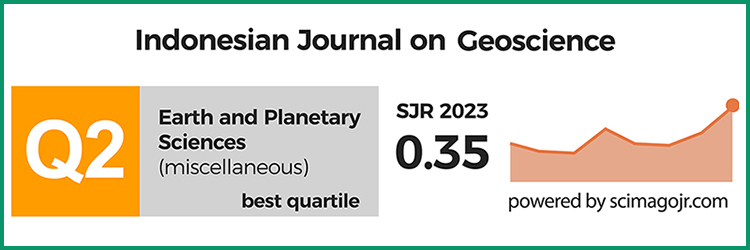Spatial Variability in Macro- and Microtextures of A Tropical Intermontane Peatland: Preliminary Investigation into The Kutai Lake Peat System, East Kalimantan, Indonesia
DOI:
https://doi.org/10.17014/ijog.8.2.275-296Keywords:
Holocene, Indonesia, tropical peat, Muara Siran, spatial variability, micro texture, macro textureAbstract
DOI:10.17014/ijog.8.2.275-296
Peat deposits of the Muara Siran, East Kalimantan area, were investigated for their vertical and lateral succession, to examine the characteristic variability, particularly its macro- and microtextures. The deposits are situated in the Kutai Basin, in the vicinity of several Cenozoic coal deposits. Peat samples were taken from twenty-seven coring sites in the area, using a MacCaulay peat corer. The Muara Siran peatlands lie between the Kedang Kepala and Belayan Rivers. Siran Lake lies between these rivers and within the peat system. The peat thickness varied from 0.5 m to 12 m. Decomposed sapric peat formed the basal and margins of the deposit, overlain by moderately decomposed hemic peat in the central part of the peatlands, though both sapric and hemic peat types are interbedded at the margins of the mire. The fibric peat types were found mostly at the top of the mire and only distal from any active streams. Twenty-four samples of peat were freeze-dried for petrographic analyses of both plant part and maceral analyses using a reflected microscope. On the average, the dominant plant parts were stems and wood (i.e. secondary xylem). Maceral composition was mostly from the huminite group (on the average 89%), particularly the macerals humodetrinite and textinite. Macroscopic peat type and microscopic composition are linked. Fibric peat was found to be rich in wood and textinite. Hemic was mostly composed of stems and wood with textinite and humodetrinite as the most abundant macerals. Sapric peat has near equal proportions of stems, wood, and macerated tissue. Humodetrinite is the most abundant maceral in sapric. The average ash and sulfur content were low, 1.29 wt.% and 0.11 wt.%, respectively. Understanding the physical characteristics of inland peat as in Muara Siran peatland is essential to build knowledge of how inland peat is formed and what makes it different from coastal peat. Muara Siran is a unique, relatively small peatland in the central eastern Kalimantan which is still considerably pristine, hence may serve the aim of this study well.



















